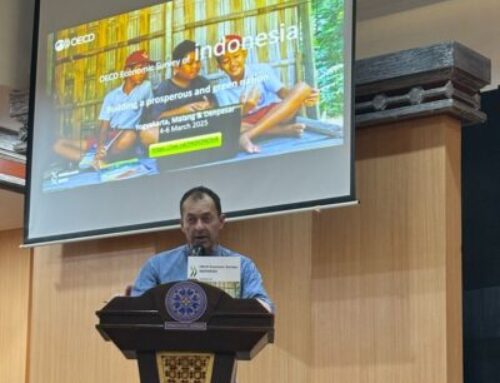FKP hosted by ANU Indonesia Project with Professor Ian Coxhead (University of Wisconsin – Madison). Friday, 8 October 2021. Dr Kimlong Chheng (Asia Vision Institute) chaired the seminar.
KEY POINTS:
- Emerging Asia’s low-income economies have acquired a way out of severe poverty by enlisting their blue-collar workers in the global production system. Aggregate incomes have risen, and poverty and deprivation have fallen dramatically. However, there is increasing evidence that dynamic job growth for less-skilled workers is depressing returns on educational investments and impeding improvements in school attainment. This is the source of the tension, that income growth is typically thought to be good for education, but at the same time the skill premium is reduced, which reduces the demand for education.
- In lower-income economies, trade raises incomes but also likely compresses the skill premium. For longer-term development, it means that efforts to hit educational development targets such as improvements in schooling, teacher training, curriculum reform, and subsidies are going to become more costly because it has to overcome the skill premium compression effect from booming tradable sectors.
SUMMARY
- Emerging Asia’s low-income economies have acquired a way out of severe poverty by enlisting their blue-collar workers in the global production system. Aggregate incomes have risen, and poverty and deprivation have fallen dramatically. However, there is increasing evidence that dynamic job growth for less-skilled workers is depressing returns on educational investments and impeding improvements in school attainment. Professor Ian Coxhead from the University of Wisconsin – Madison talks about the tension between employment and schooling in emerging Southeast Asian economies.
- Educational attainment in the labor force had risen very fast in Asian countries. However, more recent gains are quite modest, despite a still very rapid income growth. There are several countries which in the last few years are leveling off, those countries include Thailand, China, Vietnam, and Indonesia. These emerging economies have been increasingly engaged in international trade in the past decades. Trade typically leads to specialization and efficiency gains, and so increases total income. These patterns of specialization follow the comparative advantage of the country, which depends on abundant resources (including labor).
- In an economy in which trade is being liberalized, tariffs on imported intermediates (assembly industries) typically penalize labor-intensive industries. Lowering tariffs would raise profits and encourage investment in these assembly industries (such as garments, footwear, simple electronics). However, these industries are dominated by blue-collar employment and their growth is matched by job creation in often very low-skilled services. Therefore, while it raises incomes, trade may also compress skill premiums (the ratio of skilled wages to unskilled wages). It means that lower-skilled wages grow faster than higher-skilled wages. This is the source of the tension, that income growth is typically thought to be good for education, but at the same time the skill premium is reduced, which reduces the demand for education.
- In general, studies of low-income countries show that the skill premium is compressed by trade. In terms of education response, a recent study by Blanchard and Olney (2017) on 102 countries for 45 years concludes that the expansion of agriculture and low-skilled manufacturing exports is negatively associated with educational attainment. In average low and lower-mid-income countries, a 10% increase in low-skilled manufacturing exports causes almost 2 months less schooling over the entire labor force.
- In Indonesia, a previous study by Amiti and Cameron (2012) shows that in Indonesian manufacturing, lower tariffs on imported inputs reduce the within-firm skill premium, which might indicate that the overall effect (including extra-firm jobs) is likely worse. This might help understand the declining returns to schooling in Indonesia during the 2000s resource export boom. One possible causal pathway goes from the boom of resource exports to increased demand for services, creating many low-skilled informal jobs. Informal services jobs often offer low returns to cognitive skills and discourage employer investments in training, which in general are discouraging both schooling and post-school education.
- In Southeast Asia countries, exports/GDP has risen rapidly, but the skill-intensity of exports has not. Vietnam, for example, has been experiencing very rapid globalization and transformation of the economy, reorienting it towards trade and moving its labor from the traditional sector into the trade/export sector. During this transformation, average years of schooling in the labor force have risen. However, the upper-secondary enrollment rate has not subsequently increased. In 2007-14, the share of the labor force with university degrees increased only from 4% to 8%. The share with secondary or vocational education remained stable, at about 20%. More interestingly, estimates of returns to a year of additional schooling peaked in 2008-2010 and have since declined.
- District-level data in Vietnam shows that the greater the share of FDI employment, the higher the propensity for children to be out of school at the age of 15. In Vietnam, any 9th-grader wishing to enter the upper secondary school must take and pass an entrance exam. The propensity to take the exam indicates demand for education beyond the lower secondary level. Although the national average test-taking rate is 80%, it is important to look at test-taking rates in provinces with below-average per capita income (non-elite, regular families). Coxhead’s study shows that the concentration of FDI employment in these districts has a significant negative influence on the propensity for children to take the test. This is strong evidence that the demand side of the skilled labor market plays a significant role in the decision to continue school once they reach working age.
- By exploiting comparative advantage in relatively low-skill activities there could be persistence that the success of those industries discourages investments in education and therefore maintains for a longer period comparative advantage in low-skill industries, resulting in a low-skill trap. Furthermore, young people must choose between joining the low-skill labor force at an early age, or staying at school in hope that additional education will be rewarded in the future. The current experience of their peers and preceding cohorts suggests that returns to additional schooling below university will not be rewarded.
- In conclusion, in lower-income economies, trade raises incomes but also likely compresses the skill premium. For longer-term development, it means that efforts to hit educational development targets such as improvements in schooling, teacher training, curriculum reform, and subsidies are going to become more costly because it has to overcome the skill premium compression effect from booming tradable sectors. Also, the government’s aspirations to become a “knowledge economy” may recede, because the fraction of children continuing in school has begun to grow much more slowly in recent years than it had in the very early years of modern economic development.
- What are the implications for educational policy? Investment and development in education (supply side) is still very important, but the impact of school reforms will always fall short of goals so long as the labor market still favors blue-collar jobs. Investments in increased schooling may even be counterproductive if they further reduce the skill premium as explained earlier. Therefore, policies on the demand side of the labor market must complement the education investments and initiatives. The government needs to work with employers to upgrade skills and reduce mismatches, subsidize skill demand through capital market/tech transfers, and encourage belief in a more skill-intensive economic future.





